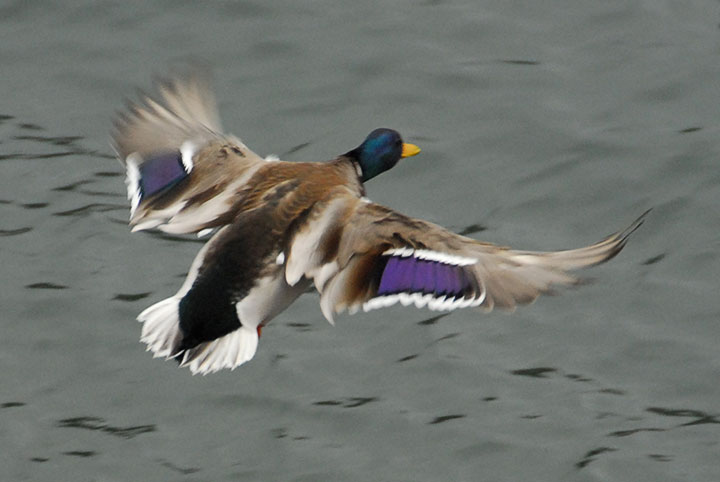Mallards, a dabbling duck
Mallards are so common around the Lake as to seem unremarkable. Yet, the breeding success and affability of this duck makes it one of the most delightful birds to watch. Mallards form pairs in the fall and remain together until eggs are laid. The female then looks after the chicks, while the male joins other males and moults to a plumage which makes him look like a female.
 Male (left) and female (right) Mallards fly by.
Male (left) and female (right) Mallards fly by.
 Mallards are comfortable in the water.
Mallards are comfortable in the water.
 Mallard are comfortable on land.
Mallard are comfortable on land.
 Mallard male, breeding plumage
Mallard male, breeding plumage
The well known look of the mallard male is actually only to be seen during the breeding season.
 Mallard male, eclipse plumage in August
Mallard male, eclipse plumage in August
At the end of the breeding season, the mallard male molts and, until mid fall, assumes a plumage similar to that of the female.
But, the sexes are distinguishable by the bills. The male’s bill is yellowish while the female’s bill (picture right) is orangish with a dark central patch.
 Mallard hen.
Mallard hen.
 A mallard chick has the look of a female.
A mallard chick has the look of a female.
 One only sees the female mallard with chicks. The male leaves when the eggs are laid.
One only sees the female mallard with chicks. The male leaves when the eggs are laid.
 Chicks can swim immediately, but will not fly for nearly two months.
Chicks can swim immediately, but will not fly for nearly two months.
 Mallards are surface feeders and will often be seen dabbling in the shallows where they will tip up and extend their beaks down to the lake bottom where they rummage around for food.
Mallards are surface feeders and will often be seen dabbling in the shallows where they will tip up and extend their beaks down to the lake bottom where they rummage around for food.
 The dabbling of mallards often leaves little pits carved out of the lake bottom.
The dabbling of mallards often leaves little pits carved out of the lake bottom.
 These dabble pits become visible along the shore during the low water of March and April.
These dabble pits become visible along the shore during the low water of March and April.
 Plant material that falls on the lake’s surface will become concentrated in regions of convergence and provide mallards with a good feeding area.
Plant material that falls on the lake’s surface will become concentrated in regions of convergence and provide mallards with a good feeding area.
 The easiest way to see the pattern on the wings is when the mallard is flying. Both the male and female (right) have a purplish speculum banded with white.
The easiest way to see the pattern on the wings is when the mallard is flying. Both the male and female (right) have a purplish speculum banded with white.
 A female mallard tips back as she prepares to land on the Lake.
A female mallard tips back as she prepares to land on the Lake.
 When resting, a mallard will often stand on one foot.
When resting, a mallard will often stand on one foot.
 When it isn't breeding season, the mallard is often quite a sociable bird and will approach humans.
When it isn't breeding season, the mallard is often quite a sociable bird and will approach humans.
 These mallards have come over to investigate a merlin that has stopped by on a hot day to bath in the Lake.
These mallards have come over to investigate a merlin that has stopped by on a hot day to bath in the Lake.
 From a distance the female mallard looks rather drab—an camouflage advantage. However, when viewed closely, she reveals intricate feather patterns.
From a distance the female mallard looks rather drab—an camouflage advantage. However, when viewed closely, she reveals intricate feather patterns.
Information from Wikipedia: Mallard.
![]()